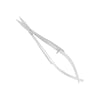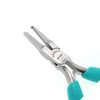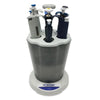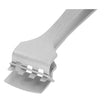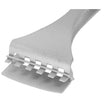- No products in the cart.
Everything you need to know about Nitinol Wires
Apr
07
2023
Nitinol, also known as nickel-titanium alloy, is a unique material that has a number of industrial and medical applications. This material is known for its excellent shape memory and super-elasticity properties. It has high strength, corrosion resistance, and biocompatibility. Nitinol wires are widely used in a variety of applications such as orthodontic wires, catheter wires, and shape memory actuators. Here is an overview of everything you need to know about Nitinol wires:
Nitinol Wire Properties
Nitinol has a unique combination of properties that make it useful in a wide range of applications. It has a high strength-to-weight ratio, excellent corrosion resistance, and biocompatibility. Nitinol also exhibits shape memory and super-elasticity, which means it can return to its original shape after being deformed, and can be stretched beyond its normal elastic limit without breaking.
Shape Memory
Nitinol wire has the ability to remember its original shape. When heated, Nitinol wire will return to its original shape. This property makes Nitinol wire ideal for applications where a specific shape is required.
Super-elasticity
Nitinol wire has the ability to be stretched beyond its normal elastic limit without breaking. This property makes Nitinol wire ideal for applications where a specific level of flexibility is required.
Nitinol Wire Applications:
Nitinol wire is used in a wide range of applications, including:
- Orthodontic wires: Nitinol wire is used in orthodontic applications due to its shape memory and super-elastic properties. It can be used to move teeth into their correct position and hold them there.
- Catheter wires: Nitinol wire is used in catheter applications due to its flexibility, strength, and biocompatibility. It can be used to navigate through the body and deliver medical treatments.
- Shape memory actuators: Nitinol wire is used in shape memory actuator applications due to its ability to return to its original shape. It can be used to move mechanical parts and control their position.
Cutting Nitinol Wire
Nitinol wire is a unique material that requires a specific set of cutting techniques. Hard wire cutters from Excelta are typically recommended for cutting Nitinol wire because nitinol is more brittle and prone to breaking. Specialty wire cutters, such as carbide cutters or diamond cutters are used specifically for cutting Nitinol wire. Additionally, Nitinol wire can also be cut using a laser cutter, which will minimize the heat affected zone, but it is a more expensive option.
If you test out the different wire cutters, you’ll find that standard cutters just pinch Nitinol wire while hard-wire cutters actually fracture the metal. Now that you know hard-wire cutters are the best tool for cutting Nitinol, you need to determine what kind of cut is the desired result. There are three types of cuts that include the following:
- Semi-flush - the bevels form a groove that is v-shaped along the cutting edge. Semi-flush is the most common cutter and has a .010” bevel cutting edge with a pinch.
- Flush - the bevels form a minimal v-shaped groove along the cutting edge. They have a .005 bevel cutting edge with a small pinch.
- Lazer flush - the Lazer flush gives you a sleek and smooth cut. There is little to no pinch on the wire and no bevel, but it leaves sharp cutting edges.
Hardwire cutters come with various configurations. These designs include different head shapes, lengths of handles, types of handles (ergonomic or traditional), cutter head width, and length of the blades.
So, when choosing the appropriate hardwire cutters, you will need to consider the following:
- Cut life is based on use and the different bevels on the cutter edges. Semi-flush cutters usually last the longest.
- Cut style falls into the categories of semi-flush, flush, and full flush.
Handling Nitinol wire
Nitinol wire is a unique material that requires specific handling techniques. It is important to handle Nitinol wire with care to avoid damaging it. Nitinol wire should be stored in a dry, clean environment and handled with clean, dry hands. Nitinol wire should be stored in a straight position to avoid kinking or bending.
In conclusion
Nitinol wire is a unique material with a wide range of properties and applications. It is known for its excellent shape memory and super-elasticity properties, making it ideal for orthodontic, catheter, and shape memory actuator applications. Cutting Nitinol wire requires specific techniques and tools, and it's important to handle Nitinol wire with care to avoid damaging it. Always consult with a Excelta tool supplier for proper cutting techniques and recommendations when handling Nitinol wire.
Where Can You Purchase Nitinol Hard Wire Cutters?
Lab Pro sells hard-wire cutters made of the highest-grade stainless steel featuring a fine cutting edge ideal for cutting varied-sized wires. They are ESD- and cleanroom-safe, resistant to corrosion, and long-lasting. Choose from a selection of cutters with carbide inserts and ergonomic grips.
Lab Pro offers a large variety of hard-wire cutters. For over 40 years, Lab Pro Inc. has been committed to delivering the highest quality chemicals, tweezers, and hard-wire cutters, lab supplies, and cleanroom PPE apparel to medical device and electronic manufacturing companies and laboratories worldwide. To learn more contact us online or at 888-452-2776.














